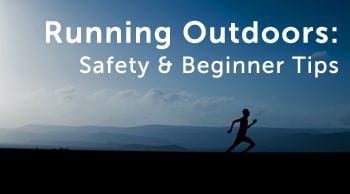Tired of Treadmills? Safely Enjoy a Run Outdoors
May 12, 2015

Spring is finally here! The weather is warmer, flowers are blooming and people are out and about outdoors. If you felt cooped up exercising in the gym all winter, you may be ready to ditch the treadmill and move your workouts outside.
While it may seem like a similar exercise, the hard-surfaced pavement, uneven terrain and the lack of a belt to propel you forward can make running outdoors feel more difficult. Take these precautions to gradually ease into the transition and prevent injury as you start to run outside:
Remember the 3 S’s: Shorter, Slower, Softer
When you switch from a treadmill and begin to run outside, be careful not to do too much too soon. With a more taxing effort on your muscles, you can be prone to shin splints, sprains or other pains if you overdo it.
Start with shorter distances
Don’t expect to run as fast or long as you did on the treadmill. Move your shorter, mid-week runs outdoors first. Then you can pick up the pace and add mileage as your body acclimates to the new regimen.
Pace yourself with your effort, rather than your speed
While the treadmill helps propel you forward at a consistent pace, the effort of running outdoors is easier to gauge through the exertion your body feels. Take your first few runs without tracking or timing you pace so that you can find a comfortable pace in which you can breathe easily. You will gradually increase your speed as you become accustomed to running outdoors.
Run on a softer surface, like grass or hiking trails.
The hard surface of pavement is less forgiving and can cause pain to your muscles and joints.
A strong, flexible body is the best injury prevention
Take 5-10 minutes to warm up with a brisk walk, and cool down with some runner-specific stretches that target your lower back, quads, hip flexors and hamstrings. Strength training that focuses on all muscle groups, like weight lifting or plyometrics, will build stronger muscles and joints so that you can prevent overuse injuries.
And don’t forget to listen to your body! If you have any small, nagging aches, it’s probably best to slow your progress to help prevent full-blown injuries.
Dress appropriately for the outdoors
Check the weather before you run to bring suitable layers or rain gear – and to set expectations! However, the most important piece of your outfit will be your running shoes.
Get a comfortable, supportive pair of sneakers with good traction. If you run often, it may be a good investment to get your shoes fitted to your foot and gait at a specialty running store.
Safety first!
Outdoor runners know it’s important to run off the street or against traffic. Make sure you’re highly visible in bright colors and reflective gear, no matter the time of day.
And while many people enjoy running with music, it’s best to leave your headphones at home as they dull your ability to hear an animal, person or car as it approaches you. The last thing you want is to get hurt or lost on a trail by yourself.
Bring a friend or dog if possible, but if you’re running alone make sure to tell someone where you’re going and bring a cell phone and ID. Stick to trails or roads you know well or that are frequently used by other runners. Popular and visible trails will be well lit, with clearly defined pathways. Check the route beforehand so that you don’t get lost, and bring a cell phone with a GPS tracker app as a backup.
